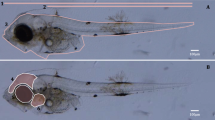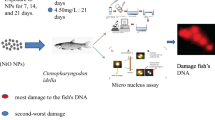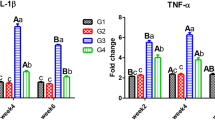Abstract
The improper disposal of sludge is a still-present phenomenon in China. The leachate formed at the bottom of the sludge pile would cause toxicological effects on aquatic organisms and affect the health of humans by entering the surrounding rivers and groundwater. In this study, the hepatotoxicity of zebrafish induced by sludge leachate was assessed by antioxidant enzyme activities, semi-quantitative histopathological assessment, and TUNEL apoptosis assay. The results indicated that the leachate would induce oxidative stress and eventually lead to an increase in lipid peroxide after a 7-day exposure. The histopathological indexes demonstrated that exposure to leachate would cause histological damage by circulatory disturbances, regressive changes, progressive changes, and inflammatory responses. According to the TUNEL results, it could be inferred that apoptotic hepatocytes increased after exposure for 7 days due to oxidative stress and histological damage. Overall, this study provided a valuable approach to assessing the toxic effects of sludge leachate and described the underlying mechanism of leachate-induced hepatotoxicity in zebrafish. This work will generate new insights into the ecological toxicity of leachate and promote the development of sludge disposal in China.
Graphical Abstract








Similar content being viewed by others
Data availability
The datasets used and/or analyzed during the current study are available from the corresponding author upon reasonable request.
References
Alabi OA, Bakare AA, Filippin-Monteiro FB et al (2013) Electronic waste leachate-mediated DNA fragmentation and cell death by apoptosis in mouse fibroblast (NIH/3T3) cell line[J]. Ecotoxicol Environ Saf 94:87–93
Alimba F (2019) Microplastics in the marine environment: current trends in environmental pollution and mechanisms of toxicological profile. Environ Toxicol Pharmacol 68:61–74
AnvariFar H, Amirkolaie AK, Jalali AM et al (2018) Environmental pollution and toxic substances: cellular apoptosis as a key parameter in a sensible model like fish. Aquat 204:144–159
Beere HM, Wolf BB, Cain K et al (2000) Heat-shock protein 70 inhibits apoptosis by preventing recruitment of procaspase-9 to the Apaf-1 apoptosome. Nat Cell Biol 2:469–475
Bernet D, Schmidt H, Meier W et al (1999) Histopathology in fish: proposal for a protocol to assess aquatic pollution. J Fish Dis 22:25–34
Bila DM, Montalvao AF, Silva AC et al (2005) Ozonation of a landfill leachate: evaluation of toxicity removal and biodegradability improvement. J Hazard Mater 117:235–242
Buchner A, Mlineck A, Calderon S (1976) Eosinophilic bodies in the epithelium of oral inflammatory hyperplastic lesions. Histopathologic and histochemical study. Oral Surg Oral Med Oral Pathol 41:378–384
Catala A (2009) Lipid peroxidation of membrane phospholipids generates hydroxy-alkenals and oxidized phospholipids active in physiological and/or pathological conditions. Chem Phys Lipids 157:1–11
Chagas TQ, da Silva Alvarez TG, Montalvao MF et al (2019) Behavioral toxicity of tannery effluent in zebrafish (Danio rerio) used as model system. Sci Total Environ 685:923–933
Chedid A, Ryan LM, Dayal Y et al (1999) Morphology and other prognostic factors of hepatocellular carcinoma. Arch Pathol Lab Med 123:524–528
Chen H, Wang C, Li H et al (2019) A review of toxicity induced by persistent organic pollutants (POPs) and endocrine-disrupting chemicals (EDCs) in the nematode Caenorhabditis elegans. J Environ Qual 237:519–525
Costa PM, Caeiro S, Lobo J et al (2011) Estuarine ecological risk based on hepatic histopathological indices from laboratory and in situ tested fish. Mar Pollut Bull 62:55–65
Costa PM, Diniz MS, Caeiro S et al (2009) Histological biomarkers in liver and gills of juvenile Solea senegalensis exposed to contaminated estuarine sediments: a weighted indices approach. Aquat 92:202–212
De Esch C, Slieker R, Wolterbeek A et al (2012) Zebrafish as potential model for developmental neurotoxicity testing: a mini review. Neurotoxicol Teratol 34:545–553
Deme GG, Ewusi-Mensah D, Olagbaju OA et al (2022) Macro problems from microplastics: Toward a sustainable policy framework for managing microplastic waste in Africa[J]. Sci Total Environ 804: 150170. https://doi.org/10.1016/j.scitotenv.2021.150170
Didden W, Römbke J (2001) Enchytraeids as indicator organisms for chemical stress in terrestrial ecosystems. Ecotoxicol Environ Saf 50:25–43
Dong WQ, Sun HJ, Zhang Y et al (2018) Impact on growth, oxidative stress, and apoptosis-related gene transcription of zebrafish after exposure to low concentration of arsenite. Chemosphere 211:648–652
Dos Santos A, Silva O, Ribeiro D et al (2021) Environmentally relevant concentrations of benzophenone-3 induce differential histopathological responses in gills and liver of freshwater fish. Environ Sci Pollut Res 28:44890–44901
Santos D, Rocha TL, Borges CL et al (2017) A glyphosate-based herbicide induces histomorphological and protein expression changes in the liver of the female guppy Poecilia reticulata. Chemosphere 168:933–943
Faber-Hammond JJ, Brown KH (2016) Pseudo-de novo assembly and analysis of unmapped genome sequence reads in wild zebrafish reveal novel gene content. Zebrafish 13:95–102
Galus M, Jeyaranjaan J, Smith E et al (2013) Chronic effects of exposure to a pharmaceutical mixture and municipal wastewater in zebrafish. Aquat Toxicol 132–133:212–222
Genchi G, Sinicropi MS, Lauria G et al (2020) The effects of cadmium toxicity. J Environ Health 17:3782
Gray P (1954) The microtomist’s formulary and guide. The Blakiston Company. Inc., New York. https://doi.org/10.1126/science.120.3121.656-b
Gu P, Li Q, Zhang W et al (2021) Biological toxicity of fresh and rotten algae on freshwater fish: LC50, organ damage and antioxidant response. J Hazard Mater 407:124620
He Y, Patterson-Fortin L, Boutros J et al (2021) Removal of biological effects of organic pollutants in municipal wastewater by a novel advanced oxidation system. J Environ Manage 280:111855
Higuchi Y (2004) Glutathione depletion-induced chromosomal DNA fragmentation associated with apoptosis and necrosis. J Cell Mol Med Oct-Dec 8(4):455–464
Huang S, Zhou C, Zeng T, et al (2020) P-Hydroxyacetophenone ameliorates alcohol-induced steatosis and oxidative stress via the NF-κB signaling pathway in zebrafish and hepatocytes. Front Pharmacol 10:1594. https://doi.org/10.3389/fphar.2019.01594
Jin Y, Zheng S, Pu Y et al (2011) Cypermethrin has the potential to induce hepatic oxidative stress, DNA damage and apoptosis in adult zebrafish (Danio rerio). Chemosphere 82:398–404
Kerr JFR, Winterford CM, Harmon BV (1994) Apoptosis. Its significance in cancer and cancer therapy. Cancer-Am Cancer Soc 73:2013–2026
Liu HRLZQ (2020) Discussion on pollutant discharge permit management of sewage treatment plant. Environ Impact Assess 42(2):27–30. https://doi.org/10.14068/j.ceia.2020.02.007
Long YY, Shen DS, Wang HT et al (2010) Migration behavior of Cu and Zn in landfill with different operation modes. J Hazard Mater 179(1–3):883–890
Lukin A, Sharova J, Belicheva L et al (2011) Assessment of fish health status in the Pechora River: effects of contamination. Ecotoxicol Environ Saf 74:355–365
Mu Y, Yu J, Ji W et al (2019) Alleviation of Pb(2+) pollution-induced oxidative stress and toxicity in microglial cells and zebrafish larvae by chicoric acid. Ecotoxicol Environ Saf 180:396–402
Nogueira P, Pacheco M, Lourdes PM et al (2010) Anchoring novel molecular biomarker responses to traditional responses in fish exposed to environmental contamination. Environ Pollut 158:1783–1790
Paravani EV, Simoniello MF, Poletta GL et al (2019) Cypermethrin induction of DNA damage and oxidative stress in zebrafish gill cells. Ecotoxicol Environ Saf 173:1–7
Qualhato G, Saboia-Morais SLD et al (2018) Melanomacrophage response and hepatic histopathologic biomarkers in the guppy Poecilia reticulata exposed to iron oxide (maghemite) nanoparticles. Aquat Toxicol 198:63–72
Ribeiro CAO, Vollaire Y, Sanchez-Chardi A et al (2005) Bioaccumulation and the effects of organochlorine pesticides, PAH and heavy metals in the Eel ( Anguilla anguilla) at the Camargue Nature Reserve, France. Aquat Toxicol 74:53–69
Serra H, Scholze M, Altenburger R et al (2019) Combined effects of environmental xeno-estrogens within multi-component mixtures: comparison of in vitro human- and zebrafish-based estrogenicity bioassays[J]. Chemosphere 227:334–344
Shaw P, Mondal P, Bandyopadhyay, et al (2019) Environmentally relevant concentration of chromium activates Nrf2 and alters transcription of related XME genes in liver of zebrafish. Chemosphere 214:35–46
Steiner C, Nolte H, Azizan A et al (2019) Quantitative proteomics for monitoring microbial dynamics in activated sludge from landfill leachate treatment. Environ Sci: Water Res Technol 5(6):1092–1101
Vitoria AP, Lea PJ, Azevedo RA (2001) Antioxidant enzymes responses to cadmium in radish tissues. Phytochemistry 57:701–710
Wang X, Wu Y, Xie R et al (2021) Effects of zinc smelting waste slag treated with root organic acids on the liver of zebrafish (Danio rerio). Bull Environ Contam Toxicol 107:167–1175
Yang Y, Ma H, Zhou J et al (2014) Joint toxicity of permethrin and cypermethrin at sublethal concentrations to the embryo-larval zebrafish. Chemosphere 96:146–154
Zezulka S, Kummerova M, Babula P et al (2013) Lemna minor exposed to fluoranthene: growth, biochemical, physiological and histochemical changes. Aquat Toxicol 140–141:37–47
Zhang DL, Hu CX, Li DH et al (2013) Lipid peroxidation and antioxidant responses in zebrafish brain induced by Aphanizomenon flos-aquae DC-1 aphantoxins. Aquat Toxicol 144–145:250–256
Zhang Y, Chen X, Gueydan C et al (2018) Plasma membrane changes during programmed cell deaths. Cell Res 28:9–21
Zhao H, Wang Y, Guo M et al (2021) Environmentally relevant concentration of cypermethrin or/and sulfamethoxazole induce neurotoxicity of grass carp: involvement of blood-brain barrier, oxidative stress and apoptosis. Sci Total Environ 762:143054
Zhou Y, Wang F, Wan J et al (2017) Ecotoxicological bioassays of sediment leachates in a river bed flanked by decommissioned pesticide plants in Nantong City East China. Environ Sci Pollut Res 24:8541–8550
Zou D, Chi Y, Dong J et al (2013) Supercritical water oxidation of tannery sludge: stabilization of chromium and destruction of organics. Chemosphere 93:1413–1418
Funding
The authors would be grateful to the National Key Research and Development Program of China (no. 2019YFC1906303), the National Natural Science Foundation of China (42177376), and the Wuxi Science and Technology Development Funds (no. N20201007).
Author information
Authors and Affiliations
Contributions
Xiaorui Wang: Conceptualization, methodology, formal analysis, and writing. Hongyue Wu: Validation and data curation. Kunlun Yang: Resources and writing—review and editing. Peng Gu: Resources and writing—review and editing. Yu Zheng: Validation and formal analysis. Manman Li: Validation and formal analysis. Yonggui Wu: Resources and writing—review and editing. Hengfeng Miao: Writing—review and editing, supervision, project administration, and funding acquisition.
Corresponding author
Ethics declarations
Ethics approval
All animal experiments were in accordance with the current Chinese legislation and were approved by Guizhou University (grant no.EAE-GZU-2020-P018).
Consent to participate
Not applicable.
Consent for publication
Not applicable.
Competing interests
The authors declare no competing interests.
Additional information
Responsible Editor: Bruno Nunes
Publisher's note
Springer Nature remains neutral with regard to jurisdictional claims in published maps and institutional affiliations.
Rights and permissions
Springer Nature or its licensor (e.g. a society or other partner) holds exclusive rights to this article under a publishing agreement with the author(s) or other rightsholder(s); author self-archiving of the accepted manuscript version of this article is solely governed by the terms of such publishing agreement and applicable law.
About this article
Cite this article
Wang, X., Wu, H., Yang, K. et al. Impact on the antioxidant system, histology, and cell death of zebrafish liver after exposure to industrial sludge leachate. Environ Sci Pollut Res 30, 24212–24222 (2023). https://doi.org/10.1007/s11356-022-23788-x
Received:
Accepted:
Published:
Issue Date:
DOI: https://doi.org/10.1007/s11356-022-23788-x




